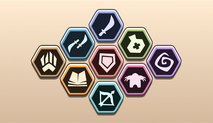Knights[]

Knights are the biggest and toughest combatants in the arena. They’re trained to withstand high levels of pain and injury, and equipped with heavy armor and large shields.
A Knight’s role is to attract attention and absorb damage while their more fragile teammates unleash fancier attacks and techniques from safely behind them. They’re best deployed along your frontlines, or perhaps at the rear flanks where they can intercept enemy Assassins and Zombies. It’s also a good idea to position Priests near your Knights, as well as any other Champion that can provide defensive buffs. This will make them even harder to break down and can lure your opponents into futile attacks against your Knights while your ranged units casually pick them off from a distance.
Such is their talent for acting as human (or inhuman) shields, that it’s easy to forget that Knights are formidable attackers too. They favour slow, powerful attacks that often have a wide area of effect and leave their enemies stunned, confused, or ideally… dead.
Type of fighting: Melee
Rangers[]

Many Classes of arena combatant have ranged attacks, but none can shoot as far or as accurately as the Rangers. Their attacks might not be the most damaging, but if you position them carefully within your formation, they’ll be able to rain down non-stop assaults on enemies all over the arena. Let your enemies get too close to your Rangers though, and they’ll be wiped out in no time.
Rangers are most comfortable on the back line, or even tucked away in corners, and always require tougher allies to hide behind. The scourge of Rangers are Assassins, who like nothing better than getting behind a line of Rangers and putting an abrupt halt to their relentless volleys of arrows.
All-in-all, Rangers aren’t the most exotic class, but combining a row of them with a protective row of melee units in front is a simple, effective and reliable strategy for novice and veteran commanders alike.
Type of fighting: Ranged
Blademasters[]

Sacrificing Armor and Health in favor of speed and Attack power, Blademasters charge headlong into battle, intent on doing as much damage as possible as quickly as they can. This is usually suicidal when attempted alone, so Blademasters are best deployed alongside other melee Champions. That way they can share the brunt of the enemies’ assaults and survive long enough to do serious damage.
Having said that, the craftiest, most cold-hearted commanders are able to exploit their Blademasters’ tendency towards dramatic, go-down-fighting heroics. This is because every time a Blademaster dies, each of his Blademaster allies gets a big damage bonus for the rest of the battle. So sometimes those suicidal lone charges aren’t as stupid as they look.
Type of fighting: Melee
Assassins[]

Assassins are the most all-or-nothing of the Classes. When deployed effectively, they’re utterly devastating. But if your opponent is well-prepared, they can go completely to waste.
Their role is to rush to the far end of the battlefield as soon as the fighting starts, and do as much damage as possible before the enemy realises they are there, preferably against vulnerable units like Rangers, Sorcerers and Priests, and ideally from behind. When these perfect conditions are met, Assassins can be used to sandwich the enemy team in an inescapable killzone. But when it goes wrong, and they find themselves face-to-face with much bigger Champions, Assassins won’t stand a chance.
Assassins are the best reason to check your opponent’s formation before a battle. If they’ve left space at their rear, and there are no strong melee units back there, then deploy Assassins to guarantee that you take an early advantage. If, on the other hand, it’s your opponent who has deployed lots of Assassins, then make sure your Champions are lined up against the back wall, with melee units at the flanks. Melee units with area-of-effect attacks are particularly effective against Assassins.
Type of fighting: Melee
Sorcerers[]

At first glance, Sorcerers might seem just like Rangers, but with shorter range and slower attack speed, but that’s only taking standard attacks into account. The whole point of Sorcerers is that while they might be a bit feeble in a stand-up fight, as soon as their Mana gauges are filled, they unleash some of the most effective special abilities in the arena. They’re defensively a little stronger than Rangers too, which can buy them just enough time to fill their Mana and counterattack before being overrun.
Sorcerers are also especially effective when deployed alongside other Sorcerers, as the more of them you have on your side, the more of your opponents’ Defense they’ll ignore. This is extremely effective against enemies with strong Defense, particularly Knights, but also against all Champions of the Empire and Light Origins.
Type of fighting: Ranged
Priests[]

Their healing powers make Priests highly valuable in the arena, especially when commanded by a Legend who also has healing powers. A team with a lot of high level Priests can be so difficult to kill that their lack of attack power ceases to be an issue. They can just wear the enemy down while refusing to allow each other to die.
If you’re facing Priests, you should make it a priority to take them down as soon as possible, otherwise all the hard work of your attacking units is likely to be undone in an instant. This is easier said than done, given that Champions generally prefer to just hit whoever happens to be standing in front of them. Under such circumstances, Assassins can prove very effective, or else simply lumping the entire team together as close to the Priest as possible, in the hope that they can hack their way through from the front.
Type of fighting: Ranged
Beastmasters[]

Beastmasters have the best starting stats in the arena. Their attack, defense, health, speed are all high. But there’s a catch.
They’re only that good when their health is at least 50%. Anything below that and the mount is defeated, forcing the rider to fight on alone, and they’re much, much weaker that way. Beastmasters do all have powerful special abilities, and these are not weakened after the mount is defeated. So even after being forced onto their feet, Beastmasters still have it in them to turn the tide of battle with a single action.
These mounted Champions pose a bit of a conundrum for arena commanders. Putting them on the frontline risks exposing them to an early dismount, but hiding them further back doesn’t make use of their considerable attacking power. With the right balance though, Beastmasters are a powerful tool in a commander’s arsenal, especially those who prefer a direct assault style.
Type of fighting: Some are melee, others ranged
Summoners[]

While Sorcerers use magic to propel extra-large balls of pain at their enemies, Summoners use it to conjure fresh new allies onto the battlefield. If you get the positioning and timing just right, then Summoners can be even more effective than Assassins at disrupting your opponent’s formation. Summoned creatures can get both among and behind enemy lines with devastating effect.
But Summoners are also harder to use than Assassins, for two reasons. First, they’re absolutely hopeless in a one-to-one fight, so protecting them is as necessary as it is difficult. And second, the commander has little control over the timing and positioning of the summon, so even with careful planning, it still requires a lot of luck to get a summoned creature into the right place at the right time. Still, even without perfect timing, the added force of numbers Summoners bring is often enough to turn the tide of battle.
Type of fighting: Ranged, Melee
Shapeshifters[]

Shapeshifters are a kind of cross between Assassins and Summoners. They’re like Summoners in that they’re very weak in themselves but once their Mana bar fills, they unleash an extremely powerful creature. But while Summoners summon the said creature, Shapeshifters become it.
And they’re like Assassins because they sacrifice Defense for intense, sudden attack power. The differences are that their attacking bursts happen later in the battle than Assassins’, and that they tend to favor mass carnage over deadly precision. Their Defense is low even after shapeshifting though, so it’s vital that they inflict maximum carnage as quickly as possible before they inevitably succumb to enemy assault.
Type of fighting: Melee

